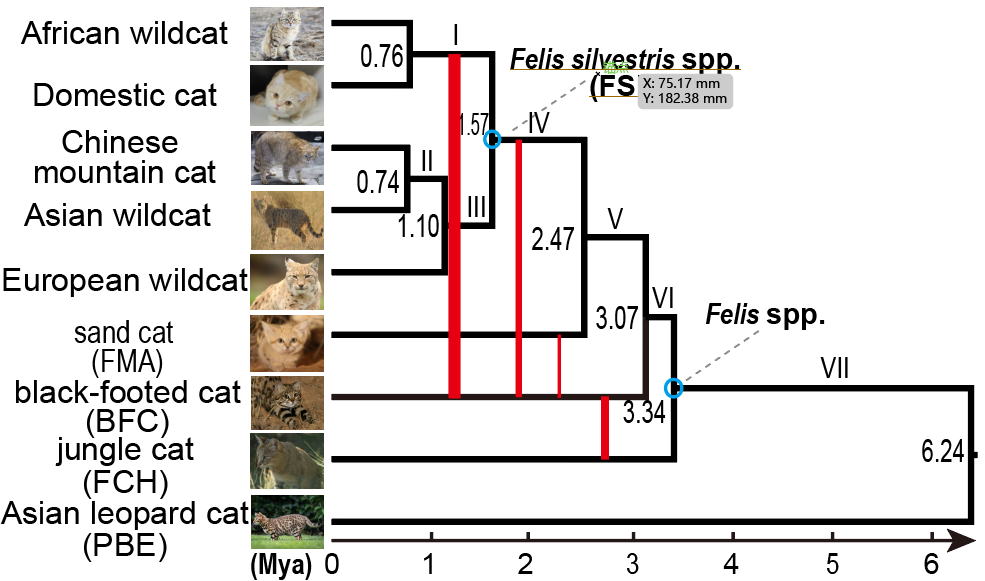species tree of Felis spp.

The genome of the black-footed cat: Revealing a rich natural history and urgent conservation priorities for small felids
Habitat degradation and loss of genetic diversity are common threats faced by almost all of today's wild cats. Big cats, such as tigers and lions, are of great concern and have received considerable conservation attention through policies and international actions. However, knowledge of and conservation actions for small wild cats are lagging considerably behind. The black-footed cat, Felis nigripes, one of the smallest felid species, is experiencing increasing threats with a rapid reduction in population size. However, there is a lack of genetic information to assist in developing effective conservation actions. A de novo assembly of a high-quality chromosome-level reference genome of the black-footed cat was made, and comparative genomics and population genomics analyses were carried out. These analyses revealed that the most significant genetic changes in the evolution of the black-footed cat are the rapid evolution of sensory and metabolic-related genes, reflecting genetic adaptations to its characteristic nocturnal hunting and a high metabolic rate. Genomes of the black-footed cat exhibit a high level of inbreeding, especially for signals of recent inbreeding events, which suggest that they may have experienced severe genetic isolation caused by habitat fragmentation. More importantly, inbreeding associated with two deleterious mutated genes may exacerbate the risk of amyloidosis, the dominant disease that causes mortality of about 70% of captive individuals. Our research provides comprehensive documentation of the evolutionary history of the black-footed cat and suggests that there is an urgent need to investigate genomic variations of small felids worldwide to support effective conservation actions.
Estimated divergence times of the volvocine algae

Fossil-calibrated molecular clock data enable reconstruction of steps leading to differentiated multicellularity and anisogamy in the Volvocine algae
Throughout its nearly four-billion-year history, life has undergone evolutionary transitions in which simpler subunits have become integrated to form a more complex whole. Many of these transitions opened the door to innovations that resulted in increased biodiversity and/or organismal efficiency. The evolution of multicellularity from unicellular forms represents one such transition, one that paved the way for cellular differentiation, including differentiation of male and female gametes. A useful model for studying the evolution of multicellularity and cellular differentiation is the volvocine algae, a clade of freshwater green algae whose members range from unicellular to colonial, from undifferentiated to completely differentiated, and whose gamete types can be isogamous, anisogamous, or oogamous. To better understand how multicellularity, differentiation, and gametes evolved in this group, we used comparative genomics and fossil data to establish a geologically calibrated roadmap of when these innovations occurred.
Gene trees of Scutellaria by BI

Phylogenomics analysis of Scutellaria (Lamiaceae) of the world
Scutellaria, a sub-cosmopolitan genus, stands as one of the Lamiaceae family’s largest genera, encompassing approximately 500 species found in both temperate and tropical montane regions. Recognized for its significant medicinal properties, this genus has garnered attention as a research focus, showcasing anti-cancer, anti-inflammatory, antioxidant, and hepatoprotective qualities. Additionally, it finds application in agriculture and horticulture. Comprehending Scutellaria’s taxonomy is pivotal for its effective utilization and conservation. However, the current taxonomic frameworks, primarily based on morphological characteristics, are inadequate. Despite several phylogenetic studies, the species relationships and delimitations remain ambiguous, leaving the genus without a stable and reliable classification system.